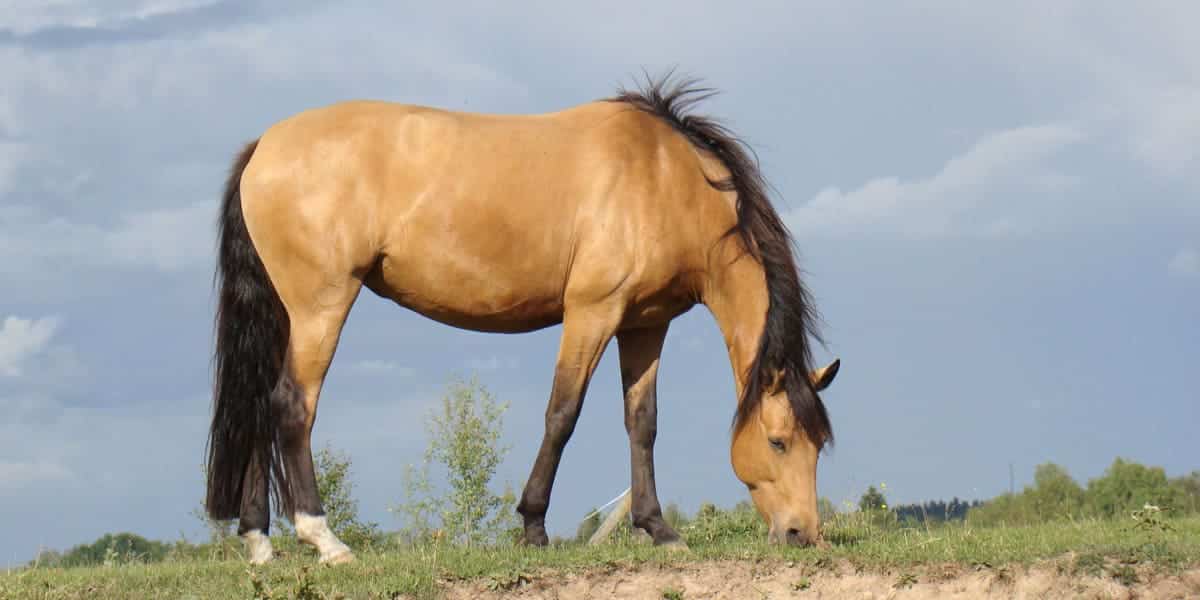Bay Horses Color: What Makes a Bay Horse?
Bay horses are named because of the coloring of their coat. Bays are distinctive in the reddish brown color of their coat, and the black points throughout their body. Typically, the black points on a bay can be found on their mane, ears, tail, and legs. Bay horses have to have two unique coloring features in order for them to be considered a Bay: the ‘black points’ or markings, and the dark red to brown coat color.
What are the Genetics of a Bay Horse?
According to research, the Bay coloring in horses is caused by the interaction of two specific genes.
- (E) Extension Locus Gene
- (A) Agouti Locus Gene
The (E) Extension Gene is dominant, and it allows for dark pigment to show up in the coat color of a horse. So, with Bay horses, there is always at least one copy of the (E) Extension allele, although the makeup can be either E/E or E/e.
The (A) Agouti Gene tells the dark black pigment on a horse where to go. In the case of Bay horses, (A) is also a dominant genetic trait. The black base color through the (E) Extension gene is restricted through the combining with the (A) Agouti gene. This is what causes Bays to have black points only on certain spots of their body, resulting in a genetic profile of E/Aa or E/AA.
50 Shades of Bay… Horse Colors
Although the most common coloring of a standard Bay horse will be that reddish brown color, there are actually a wide range of colors. These are some of the most commonly recognized variations in Bays.
Copper Bay Horses

Copper Bay horses are extremely close to the standard Bay coloring. However, Copper Bay is a bit lighter than standard Bay. The coat color on these horses tends to be more of an orange-red shade, similarly to a copper penny.
Golden Bay Horse

A golden Bay, also called light Bay, is the lightest variation of the Bay coloring out there. Often, golden Bays are mistaken for Buckskin horses. A light Bay is not common to see, and their coat color is often light red to golden.
Blood Bay Horse Color

A lot of people think that blood Bay is the standard Bay coloring, but this isn’t the case. The blood Bay horse color is actually very rare to find. True blood Bay horses will have a darker red coat with the distinctive Bay black points. In certain lightings, the blood Bay color can look close to a mahogany. It’s not known what causes blood Bays to come out much more red although they have the same Ee/AA genetic composition.
Dark Bay Horse

Also referred to as a mahogany Bay, dark Bay horses are the darkest coloring of the Bay coat color. Dark Bay horses have a very deep and rich reddish brown coat that appears as a really dark shade of brown.
Buckskin Bay Horses

Buckskin Bay horses will range from a cream-like color all the way to a yellow tint. Buckskin Bays are caused by the single cream dilution gene. A typical buckskin Bay will be a true buttermilk shade.
Bay Dun Horses

Bay dun horses are very similar to buckskins. The primary difference between buckskin and duns in Bay horses is that duns will have their distinctive dorsal stripe.
Wild Bay Horses

Wild Bay horses are exactly like standard Bay horses with one exception: the black points. On wild Bays, their black point markings don’t go up nearly as high on the legs as with standard Bays. Researchers believe that this is caused by the pangare gene. This gene causes certain parts of the horse coloring to be lighter.
Bay Pinto Horse

Pinto horses sort of remind me of some type of art project. These horses have a pattern on their coat that is caused by the white spotting genetic trait. In Bays, pintos will have a brown coat with white splotches all over, including their legs. These horses are also referred to as paint horses, and rightfully so. It looks like someone threw paint all over them – in the best way possible.
Silver Bay Horses

Putting aside the fear of being a little bit biased, I think that silver Bays are just so beautiful! They are pretty rare to find. These horses have a dark brown coat with lighter tails and manes.
Roan Bay Horses

Typically, roan Bays have a unique mix of white hairs and dark colored hairs in their coat. These horses have at least 1 dominant roan gene.
Breeds of Bay Horses
Can you find a Bay horse in every horse breed? The short answer is no. First, let’s talk about the breeds that will not have any Bay colored horses. In most cases, these are purebred horses.
- Friesian Horses
- Haflinger Horses
- Suffolk Punch Horses
Now, let’s talk about the list of horses that can have Bays.
- Clydesdale – The most common breed for the Bay color to appear in is the Clydesdale breed!
- Thoroughbred
- Quarter Horse
- Tennessee Walking Horse
- Arabian
- Andalusian
Clydesdale Bay Horses

Since the most common breed of Bays is a Clydesdale, when asked about the temperament of Bay horses, most people are referring to the breed of Clydesdales. Since Bay is a color and not a breed, there is not really a certain attitude or temperament associated with the coat color alone. However, there are some pretty unique characteristics in Clydesdale horses.
Clydesdale horses are commonly known as gentle giants. If you’ve ever owned a Clydesdale, you can probably attest to this. Purely due to the size of their hooves alone, these horses tower above other breeds. Not only do they have huge feet, but their hooves are extremely strong, too.
The Clydesdale breed is calm, gentle, and extremely smart. In most cases, Clydesdales are used for riding or driving carts. They can also be used for work. Because of their beautiful appearance, Clydesdales also make excellent show horses.
Despite their large build, Clydesdales are a popular choice for horse lovers because of their docile temperament. They are also very easy to train because of their intelligence.
How Much Do Bay Horses Cost?
Bay horses don’t cost any more solely based on their coat coloring. The big variation in price when it comes to purchasing a horse largely depends on the breed of horse that you’ll be buying. On average, when buying a horse, you can expect to spend anywhere from $500 – $10,000.
Of course, purchasing a horse isn’t the only expense to occur when it comes to horse ownership. You’ll have to think about all the costs – both small and large. Equipment and boarding for the horse, vet and farrier costs, food, and a horse trailer.
Read more: Horse Ownership for Beginners: The Ultimate Guide for Beginner Horse Owners
With this information on Bay horses, you’ll be an expert! We hope that this information on the Bay horse color satisfied your equine knowledge desires. Want to learn more? Keep reading on the Double D Trailers blog.
Frequently Asked Questions
What’s the difference between a bay horse and a brown horse?
A brown horses is typically a shade of brown all over its body, while a bay horse has distinctive black points.
What colors look the best on bay horses?
When it comes to dressing your bay horse, the colors that tend to complement standard bays the best are browns, taupes, coppers, and pastels.
What color are bay horses born?
Bay foals have darker coats that usually lighten over time.
What’s the difference between a bay roan and a red roan?
A red roan has dark red points while a bay roan has black points.
Can a bay horse have a cream gene?
Horses that have a bay coat color and also carry the cream gene will be considered a buckskin or perlino.
Is bay a dominant gene in horses?
Yes, bay is dominant.






